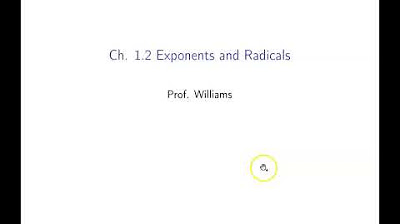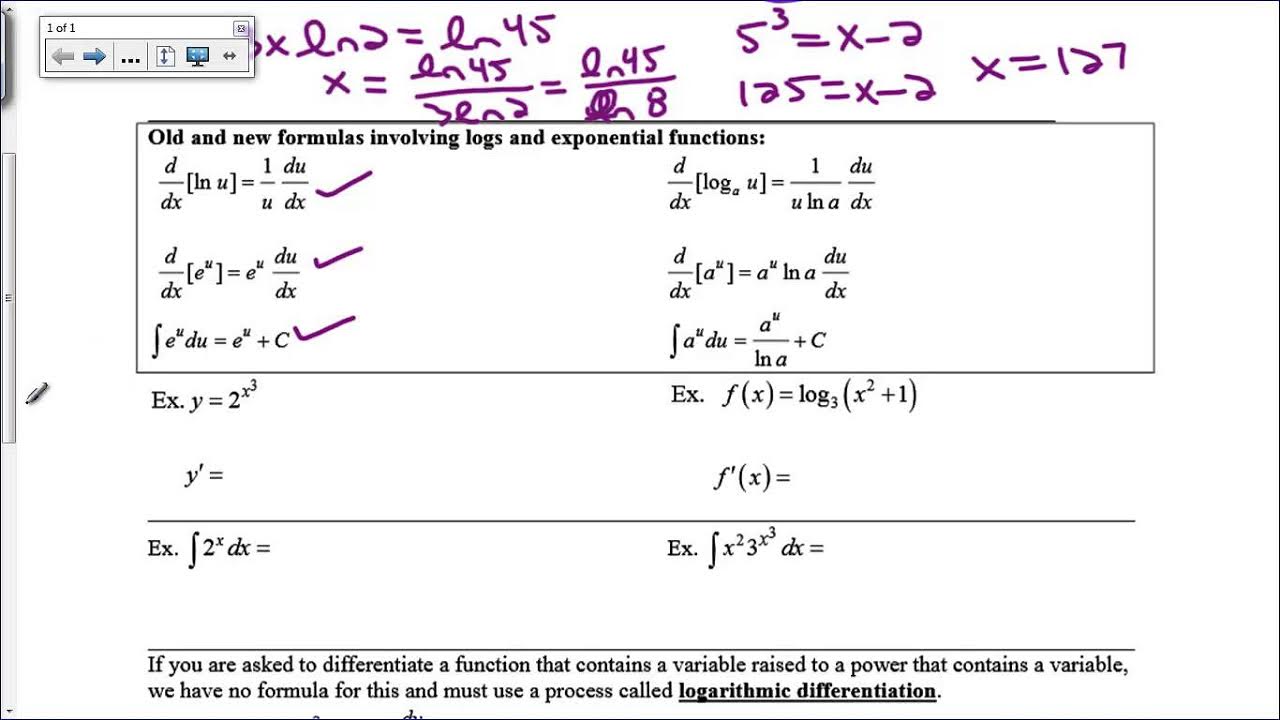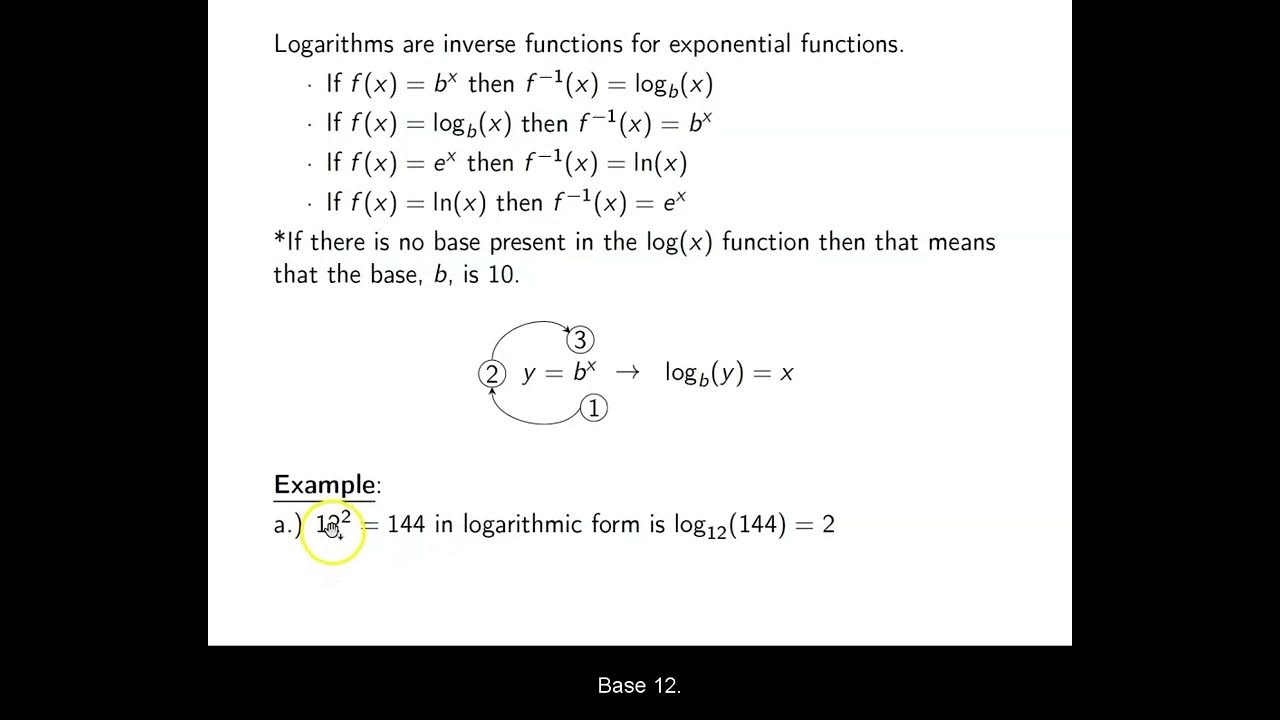Math 8 7 3 Homework Help Morgan
TLDRThis educational video script explores the concept of powers of ten, focusing on the volume of a giant cube with 10,000 km sides, and introduces the rule for raising a power to a power by multiplying exponents. It provides examples, including converting large numbers into exponential form and applying this knowledge to real-world scenarios like stacking cubes and amoeba division. The script also includes a problem-solving section with equations to determine age relationships and emphasizes the utility of exponential notation for simplifying large numbers.
Takeaways
- 📚 The lesson focuses on understanding powers of powers, specifically how to calculate the volume of a cube with each side measuring 10,000 kilometers.
- 🔢 To find the volume of such a cube, multiply each side (10,000 km) by itself three times, which simplifies to 10,000^3 or 10^{12} cubic kilometers.
- 📈 The concept of converting numbers to base 10 is introduced, which helps simplify calculations by adding exponents instead of multiplying large numbers.
- 💡 When a power is raised to another power, the exponents are multiplied together. For example, 10^4 raised to the third power is 10^{4 * 3} = 10^{12}.
- 📘 Activity examples demonstrate how to apply these rules, such as calculating the volume of a cube formed by oil consumption or stacking one million one-inch cubes.
- 🌐 The script discusses the exponential growth of amoebas, showing how their numbers increase rapidly over time using powers of two.
- 🧩 The problem of fitting a square of one million cubes in a classroom is tackled by converting the number of cubes into a base 10 expression and calculating the side length of the square.
- 🏗️ The script explores the idea of layering small cubes to form a larger cube, using the concept of volume to determine the dimensions of the larger cube.
- 👧🏻👦🏻 A word problem involving the ages of Elena and Kate is presented, using equations to represent their ages and the relationship between them.
- 📉 The lesson emphasizes the importance of understanding and applying exponential notation, which simplifies complex calculations and makes them more manageable.
Q & A
What is the main topic of the video lesson?
-The main topic of the video lesson is powers of powers, specifically focusing on how to calculate the volume of a cube with sides of 10,000 kilometers and understanding the concept of raising a power to another power.
How does the script simplify the calculation of the volume of a giant cube with 10,000 km sides?
-The script simplifies the calculation by expressing the volume calculation as 10,000 multiplied by itself three times, then converting it to exponential notation, which is 10 to the power of 12 (10^12), instead of the more cumbersome 10,000 * 10,000 * 10,000.
What is the significance of converting numbers to base 10 in the context of this lesson?
-Converting numbers to base 10 allows for easier manipulation and understanding of large numbers, especially when dealing with powers and exponents. It simplifies the process of adding exponents when multiplying numbers with the same base or multiplying exponents when raising a power to another power.
What rule is introduced in the lesson for calculating the volume of a cube when all sides are equal?
-The rule introduced is that the volume of a cube, where all sides are equal and represented as a power of 10, can be calculated by raising the base to the power of the exponent multiplied by three, since volume is length * width * height.
How does the script illustrate the concept of a power to a power?
-The script illustrates the concept by showing that when you have a power to a power, you multiply the exponents together. For example, (10^4)^3 equals 10^(4*3), which simplifies to 10^12.
What is the volume of oil in cubic meters if a cube of oil is made with oil consumed in two months, and each side of the cube measures 10^3 meters?
-The volume of oil is 10^9 cubic meters, as the volume is calculated as (10^3)^3, which simplifies to 10^9.
What is the height in miles of a tower made by stacking one million 1-inch cubes on top of each other?
-The height of the tower is approximately 15.78 miles, after converting the total height in inches to feet and then to miles.
How can the height of the tower in the previous question be expressed in feet and miles?
-The height of the tower is approximately 833,333 feet, which is equivalent to about 15.78 miles when converted.
What is the dimension of a large cube formed by layering one million 1-inch cubes?
-The dimension of the large cube is 100 inches by 100 inches by 100 inches, as the volume calculation involves raising 10 to the power of 6 (10^6), which means each side of the cube is 10^2 or 100 inches.
How many amoebas are there after 24 hours if they double every hour starting with one?
-After 24 hours, there would be 2^24 amoebas, which is 16,777,216.
Why might exponential notation be preferable to express large numbers in certain contexts?
-Exponential notation is preferable because it is more concise and easier to work with when dealing with very large numbers, especially in calculations involving powers and exponents.
What is the correct system equation that matches the story about Elena and Kate's ages?
-The correct system equation is D: k - 9 = 2(e - 9) and e + 4 = k, which represents the ages of Elena and Kate and the relationship between them over time.
Outlines
📚 Understanding Volumes of Large Cubes and Exponential Notation
This paragraph introduces the concept of calculating the volume of a cube with sides measuring 10,000 kilometers, using both multiplication and exponential notation. The explanation simplifies the process by converting the dimensions to powers of ten, demonstrating that multiplying the same base exponents results in an addition of exponents, leading to a final volume of one trillion kilometers cubed. The paragraph emphasizes the efficiency of using base 10 and exponential rules to simplify large calculations.
🔢 Exponential Growth and Problem Solving Techniques
The second paragraph delves into the rules of exponents, particularly focusing on the scenario of raising a power to another power, which involves multiplying the exponents. It uses examples such as 10 to the third squared and 10 squared multiplied by itself five times, illustrating the process of calculating the resulting powers. The paragraph also discusses a real-world application, estimating the volume of oil consumed worldwide in two months, and converting measurements from inches to feet and miles, showcasing the practicality of exponential notation in problem-solving.
🏗️ Applying Exponents to Physical and Mathematical Problems
This section explores the application of exponents in various contexts, such as stacking one million one-inch cubes to form a tower or arranging them into a square. It discusses the process of converting large numbers into exponential form for ease of calculation and understanding. The paragraph also addresses the concept of volume calculation for a large cube formed by smaller cubes, emphasizing the use of exponent rules to simplify the process and the importance of converting units to provide meaningful answers.
🦠 Exponential Growth in Biology and Age-related Equations
The final paragraph discusses the concept of exponential growth using the example of an amoeba dividing every hour, doubling in number each time. It provides the mathematical representation of this growth and calculates the number of amoebas after a certain period. Additionally, it presents a word problem involving the ages of Elena and her cousin Kate, using algebraic equations to represent their age relationship over time. The paragraph concludes with a question about the preference for exponential notation in answering certain types of problems.
Mindmap
Keywords
💡Powers of Ten
💡Volume
💡Exponential Growth
💡Cube
💡Base 10
💡Exponential Notation
💡Squaring
💡Homework
💡Classroom
💡Age Equations
Highlights
Introduction to the concept of calculating the volume of a giant cube with sides measuring 10,000 kilometers using powers of ten.
Simplification of cube volume calculation by expressing the side length in terms of powers of ten and then adding the exponents.
Explanation of how to represent large numbers in exponential form to avoid complex multiplication.
Demonstration of converting a large multiplication problem into an addition of exponents when the base is the same.
Illustration of raising a power to another power by multiplying the exponents, as opposed to adding them.
Activity example showing how to calculate the volume of a cube formed by oil consumption data in exponential notation.
Clarification of the difference between adding and multiplying exponents when dealing with powers of the same base.
Homework problems that apply the rules of exponents to calculate volumes and heights of various geometric shapes.
Conversion of linear measurements from inches to feet and miles to demonstrate practical applications of exponent rules.
Use of exponential growth to describe the rapid multiplication of amoebas, showcasing the power of exponential functions in real-world scenarios.
Discussion on the preference for exponential notation over long multiplication for clarity and simplicity.
Word problem involving age calculations and the application of algebraic equations to represent relationships between ages.
Solution to a word problem using a system of equations to determine the ages of Elena and Kate based on given conditions.
Elimination method used to solve the age-related word problem by identifying irrelevant equations.
Final answer to the age word problem, using the correct equation that matches the story's conditions.
Conclusion summarizing the importance of understanding exponent rules and their practical applications in various mathematical problems.
Transcripts
5.0 / 5 (0 votes)
Thanks for rating:





